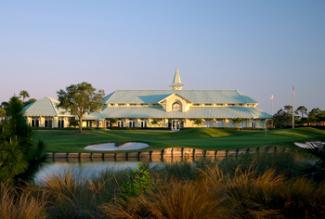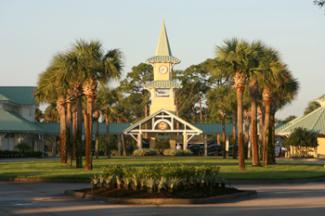Featured Golf News
PGA Village: Where the Pros & Tourists Play
One needn't have the heightened observational powers of a private eye or Secret Service agent to discern that many of the habitués of Port St. Lucie's PGA Village in south Florida are a bit different than the norm. In any corner of mid-winter Florida, whether at Doral, Innisbrook, Sandestin, PGA National, or any of a dozen other locales, the clientele has a certain look.

Clubhouse & Tower at PGA Golf Club
It might not scream "tourist" in the stereotypical manner of those clutching cameras and wearing Hawaiian shirts. But denizens of these other resorts might tend towards apple- or pear-shaped body types, wearing cargo shorts and ankle socks and. most unfortunately, possess golf swings better suited towards playing "Whack-a-Mole" than delivering the club towards the target in a fluidly powerful motion.
Now cast a sharp eye about PGA Village, not even a mile to the east of Interstate 95, about 110 miles north of Miami. There are tourists around, certainly, but also sprinkled liberally into the mix are any number of lean, keen, par-flirting machines - golf professionals (not necessarily professional golfers) taking a mid-winter hiatus to work on their games, compete against their colleagues, and enjoy one of the state's premier practice and tournament facilities.
And therein lays one of the chief attractions of this high-caliber yet somewhat below-the-radar golf destination. It's the chance to rub elbows, maybe even glean a couple of useful swing tips, from an ever-changing cast of PGA professionals, coming in from all points on the compass. And the 54 holes of golf meandering about the property are pretty darn good also!
Bob Baldassari is the prototypical long and lean pro who serves as the GM of PGA Village. He came on duty two-and-a-half years ago, after a stint at Canon Ridge Golf Club in Virginia, which is owned and operated by former PGA Tour commissioner Deane Beman.
"This is like coming to the 'Magic Kingdom' for golf professionals," offers Baldassari, who shares the same first name and profession as his father. Bob Sr. is a PGA Life Member who spent nearly 30 years as the head man at Hillview CC in greater Boston, while concurrently wintering at Kenilworth Lodge in Sebring, Fla., where he spent some two decades as head professional. Speaking of his youth, the younger Baldassari remarks: "I went to school in the spring and fall in Massachusetts, and we spent our winters in Florida. My dad was one of the first pros to make that north-south migration."
"It's an honor to be here in this position, represent my fellow PGA professionals, and work with such a dedicated staff," adds Baldassari, referring to the 260-odd employees of PGA Village. "Besides our trio of courses, we have the Center for Learning and Performance, and our private country club, located off property."

No. 7 on Ryder Course at PGA Golf Club
Commenting on the unique characteristics of PGA Village, Baldassari continues: "It's unlike any other property in the world, in that we have professional tournaments going on at different junctures, while we have public play on adjacent courses. It's a great opportunity for our visitors to see and experience high-caliber golf being played by extremely talented golf professionals, while at the same time working on their own games and playing recreational rounds with their buddies."
Some of the major events hosted at PGA Village include the PGA Assistants Championship, the PGA Senior Professional Championship, the PGA Match Play Championship, and the PGA Senior-Junior Championship. It should be noted that the winning scores in these events are normally double-digits under par over four rounds, meaning every day the top players are shooting in the 60s, or close to it.
For those hoping to shoot in the 80s, or close to it, a visit to the PGA Center for Golf Learning and Performance is in order. This 35-acre facility has more than 100 full-swing practice stations, nine bunkers, pitching and chipping practice areas, a 7,000-square-foot USGA-spec putting green, a three-hole teaching course and, if you couldn't guess, is manned by PGA teaching professionals.
The learning center is operating with a catchy new tagline, which sums up all they offer. It's called T-E-M-P-O, which stands for Technology, Equipment, Mental Game, Physical Game, and On-Course Performance. A lesson or two might be helpful in successfully navigating the three courses here, which include the Ryder and Wanamaker courses designed by Tom Fazio, and the Dye Course, by Hall-of-Fame architect Pete Dye.

Entrance to PGA Golf Club
Rodman Wanamaker was the department-store magnate who, in 1916, inspired the birth of the PGA of America. The Wanamaker Course, considered to be the preeminent championship test at PGA Village and the site of most of the major competitions on site, is set against a backdrop of wetlands, palm trees and palmettos, with plenty of encroaching water, and putting surfaces that put the 'complex' in green complexes.
By contrast, the Ryder Course - named in honor of Samuel Ryder, the namesake and founder of the Ryder Cup - is a little less stringent in its demands. It's a fun journey full of rolling hills, elevation changes, majestic hardwoods and no shortage of water. This course feels a bit more like playing in Carolina than Florida. "The Ryder Course is a bit more forgiving off the tee than the Wanamaker, but you still have to hit quality golf shots to the greens," comments Baldassari.
The Dye Course is a different animal entirely than the Fazio duo, and unusual by Florida standards. It's practically bereft of water while being linksy, open, windswept and thought-provoking. It features wide fairways pocked with heart-sinking pot bunkers and large greens with severe pitch and roll. The map says Port St. Lucie, but the Dye Course often feels like playing the links of Portmarnock outside of Dublin, with snare-drum fairways, scatter-shot pot bunkers, and out-of-nowhere mounding covered with pampas grasses.
Oftentimes the moonscape of bunkers, mounds and penal rough somewhat short of the green inhibit an aggressive golfer from going for a par-5 in two, or torture a misplayed approach on a par-4. But if a player is skillful or lucky enough to avoid these assorted pitfalls, bogeys are simple and pars well within reach. Greens are mostly open, and water practically a non-factor.
"The closing holes on the Dye Course are extremely tough," concludes Baldassari. "If you can play the last four or five holes at even-par, you're playing some quality golf."
A late January visitor to the PGA Village was none other than Jim Remy, currently serving out his two-year term as President of the PGA of America. "This is a wonderful facility," begins Remy, also the Director of Golf at Okemo Resort in central Vermont, who serves as figurehead to the 28,000 members of his association. "The courses are real quality experiences, and it's a pleasure to be around so many of my fellow golf professionals whenever I visit.
"In fact, my wife and I recently bought a winter home right here in Port St. Lucie, very close to the PGA Village, and we couldn't be happier with our decision."
For more information, visit www.pgavillage.com.
Joel Zuckerman, called "One of the Southeast's most respected and sought-after golf writers" by Golfer's Guide Magazine, is an award-winning travel writer based in Savannah, Ga., and Park City, Utah. He has written five books, including the epic "Pete Dye Golf Courses" in 2008. Joel's course reviews, player profiles, essays and features have appeared in more that 100 publications internationally, including Sports Illustrated, Golf, Continental Magazine, Travel & Leisure Golf, Sky Magazine, Golf Connoisseur, Golfweek, Estates West, Millionaire and Golf International. For more of Joel, visit www.vagabondgolfer.com.
Story Options
 |
Print this Story |
